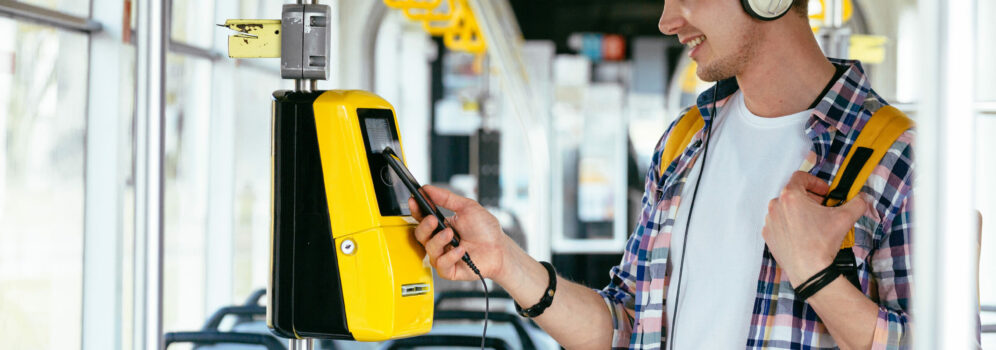Survey data collected from 21 California transit agencies finds their perception of open-loop fare collection is generally positive. However, many of the agencies that responded see challenges to adoption, including technological complexity and equipment costs.
Programs such as The California Integrated Travel Project (Cal-ITP calitp.org) remove many of these perceived barriers. With the support of expert vendors including Kuba, they offer a modular system; cost-effective, simplified procurement; and supported onboarding.
Let’s take a look at the perceptions US transit agencies have about the open-loop fare collection – and the help they can get to tap into the benefits of this technology.
Simple rider experience
Open-loop fare collection systems accept ‘taps’ from credit and debit cards and mobile wallets. Once taps are received by a fare validator, these are communicated to a back office and aggregated. The correct fare for all trips is then calculated and charged as a post-payment.
Riders find it convenient to tap-and-go using the card or smart device they carry everywhere. And, with automated fare capping and discount verification, there’s no need to understand fare structures to get the best bang for their buck.
Transit agency benefits
For public transit agencies, open-loop fare collection means they don’t need to issue fare media (transit cards or paper tickets), or handle cash. If they phase out these alternative ticketing methods, they can cut costs significantly. Aside from that, the fast, frictionless boarding of riders reduces dwell times in stations and at bus or tram stops by up to 50%. That’s a win for efficiency, helping scheduled routes to run on time.
These benefits have spurred many transit agencies around the world to roll-out open-loop fare collection. However, until recently, it was only the giants – the likes of Transport for London, the New York Metropolitan Transportation Authority and the Chicago Transit Authority – that had the resources to invest. The cost of introducing new systems and driving adoption (factoring in equipment, software upgrades, staff training and marketing) seemed out of reach for many small and medium sized transit agencies.
Levelling the playing field
Cal-ITP aims to change that by creating a Mobility Marketplace that makes open-loop fare collection accessible to all transport agencies. To make procurement easier and more affordable, the State of California has awarded master service agreements to vendors (including Kuba) whose products and services can be purchased through the marketplace. Agencies can use pre-arranged contracts and enter into a fast onboarding process.
Challenges to open-loop fare collection
The study, conducted by Transport Findings, investigated the challenges transit agencies face when considering open-loop fare collection. It also asked them about their interest in assistance programs to help them get started, like the one offered by Cal-ITP.
Of the 21 smaller transit agencies that responded, 81% had an interest in open-loop fare collection: 29% had considered implementation; 38% were currently considering it; and 14% were rolling-out the technology.
The below chart shows the challenges they anticipate. Technology and infrastructure concerns were more selected by more agencies than other factors. Uncertainty about rider adoption were selected by about a quarter of agencies.

Expected passenger barriers to open-loop payments
Transit agencies participating in the study also reported potential barriers their riders might face if the agency transitioned to open-loop payments. Passengers without bank accounts or who are reliant on cash may be less able to adapt to open-loop payments. Agencies also thought passengers might initially find it hard to adapt to new technology.
 Transit agency gut instincts about open-loop
Transit agency gut instincts about open-loop
Survey respondents had positive sentiments about open-loop fare collection more generally. The majority (71%) agreed or strongly agreed that open-loop transit payments improve operational efficiency, while about half agreed that they will make inter-agency transfers easier for passengers. At least 50% felt there was support for open-loop payments among local groups – including planners, local government, community organisations and riders.
Breaking down barriers
This survey showed a clear interest among US transit agencies in open-loop payments, but also a range of perceived blockers that were holding some of them back. To boost agency confidence and accelerate the roll-out of open-loop fare collection, Cal-ITP offers transit agencies assistance not just in California, but throughout the United States.
The survey shows strong support for this effort, with the majority of respondents stating they have used, would like to use, or would like further information about what Cal-ITP provides. This includes an option to roll-out automated discount verification using its Benefits Tool.
Accelerating the journey to open-loop
Kuba is a supplier within Cal-ITP’s Mobility Marketplace. We provide fare validators, one of three essential components of a modular open-loop fare collection system. Our existing integrations with approved vendors who provide fare calculation software and payment processing means our combined solution can be up and running within weeks.
Want to find out more? Get in touch with our team – we’ll be happy to answer your questions!
Interested to read about the first small agency in the United States to successfully deploy open-loop fare collection? Read this! Spoiler alert: they partnered with Cal-ITP, Kuba and Littlepay and achieved their number one goal to ‘leave no rider behind’!



